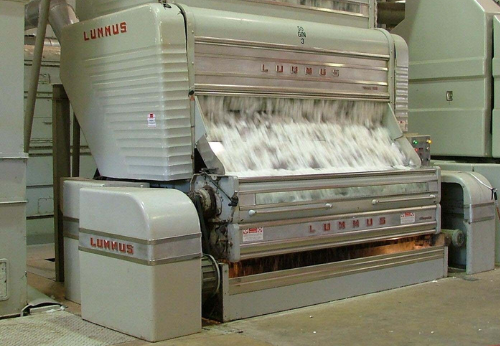In part one of our Processing Cotton series, we discussed Barnhardt Manufacturing Company’s commitment to delivering safe and sustainable cotton-containing products by forging personal relationships throughout the supply chain that begin with farmers that share our vision for quality and continuous improvement in energy, soil and water conservation.
Today, we pick-up the series during harvest. Throughout the southeastern United States, or what is also known as the Cotton Belt, cotton is planted and harvested on an annual basis. Conventional cotton is planted in March and April then harvested in November and December; whereas organic cotton is planted and harvested a few months after conventional practices. A later growing season is required for organic cotton versus conventional cotton due to the fact that organic farmers rely on freezing temperatures to defoliate their crops prior to harvesting.
During harvest, cotton is picked from the fields with farming equipment, simply called cotton pickers. There are two types of cotton pickers: round module pickers and conventional basket pickers.
Round module pickers reserve the cotton that has been picked until the machine has reached capacity. Once at full capacity, cotton modules are formed inside the picker, then wrapped in film and deposited in the field. The cotton modules produced by the round module pickers look very much like a bale of hay and are left in the field until ginning begins.
Conventional basket pickers reserve picked cotton in an internal basket. Once full, the basket is emptied into a “bowl buggy” then transported to the module builder in the field. After the modules have been made, they are covered in the fields with tarps until they are needed at the gin.
One of History’s More Impactful Inventions
Cotton modules are transported from the farm and to the next major step in the processing journey, the gin. One of the most impactful inventions in human history, the cotton gin, eliminated the labor-intensive process of removing seeds present in the cotton lint. Together, with the mechanical cotton picker, the advent of the cotton gin enabled a multi-fold increase in the amount of cotton that could be processed from the field.
Here’s an overview of what happens after the harvest:
- Modules brought to the gin from the farm.
- Modules are broken apart.
- Dryers are used to remove moisture.
- In the ginning process, cotton is transported through a series of mechanical cleaning steps where debris such as plant stalks, stems and leaves are removed along with the seeds.
- The cotton lint is then baled, tagged and labeled.
- Samples are removed from each bale of cotton ginned in the United States, labeled and then entered into a database which is governed by the United States Department of Agriculture (USDA).
- Physical samples are sent to USDA Cotton Classing Offices by region where they are graded and classified.
The sampling and classification process is efficient and world class. No other cotton-growing country is as sophisticated nor as regulated by the high standards used within the United States. Last year, there were over 20 million bales of cotton ginned in the United States.
All ginned bales are transported to warehouses, also registered with the USDA, where they are held until the classing office has completed their process and all classification data has been entered by bale number into the database. Once in the system, the bales can be consolidated with other like grades and sold to various markets worldwide.
With a cleaner, more sustainable product in hand, gins send bales of cotton fiber along multiple paths for continued processing and manufacture. For nonwovens, that means processes like purification, which we will explore in our next installment.
